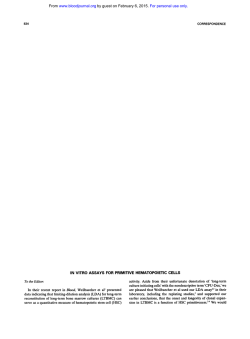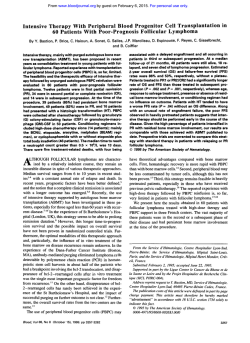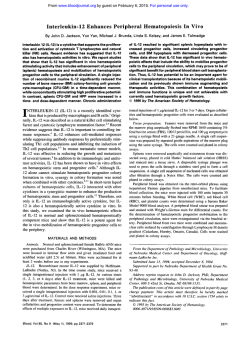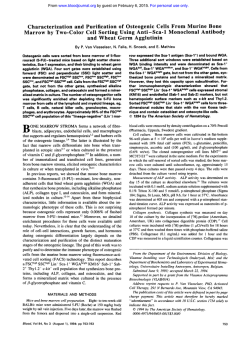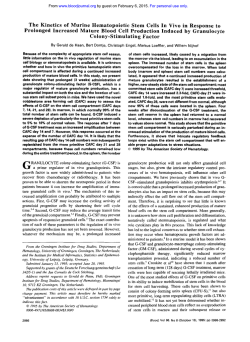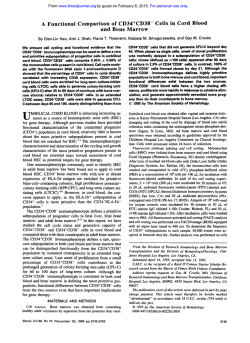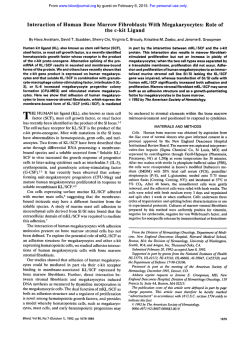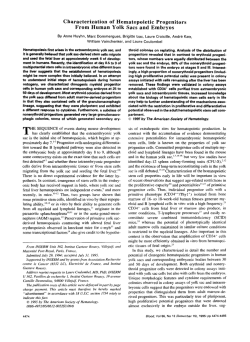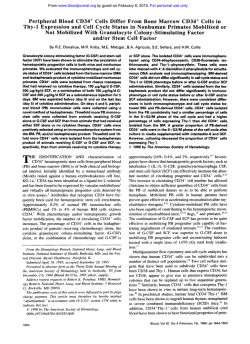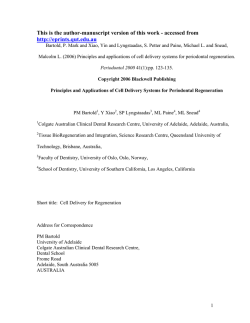
Ex Vivo Expansion of Hematopoietic Precursors, Progenitors
From www.bloodjournal.org by guest on February 6, 2015. For personal use only. REVIEW ARTICLE Ex Vivo Expansion of Hematopoietic Precursors, Progenitors, and Stem Cells: The Next Generation of Cellular Therapeutics By Stephen G. Emerson S INCE ITS INCEPTION as a medical specialty, hematology has had the unique perspective of considering therapeutics to include not only small molecular weight pharmaceuticals, but also cells themselves. Recognizing the complexity of the functions performed by the blood cells, hematologists have long understood that our best chance of harnessing the power of these cells for oxygen transport, repair of damaged endothelium, and inflammation was to transfuse large numbers of normal blood cells. By doing so, hematologists could thereby circumvent the need to understand every molecular function of these cells in complete reductionist detail, simply taking advantage of evolution’s wisdom. Cellular transfusion therapies began with mature blood cells, first with whole blood and then later evolving to the use of fractionated blood components. These therapies proved extremely effective for red blood cells and often useful for platelets, but less so for neutrophils, whose lifetimes were too short to be of practical use. Transfusion of mature longlived T lymphocytes may itself have useful clinical applications as well. Bone marrow transplantation, the second phase of cellular therapeutics, began with the realization that permanent clinical benefit from transfused blood cells could only come from transplantation of multipotent hematopoietic stem cells. Stem cell transplantation has now been conclusively proven to provide definitive therapy for a variety of malignant and inherited diseases and to also provide robust myelopoietic support for patients undergoing high-dose chemotherapy or radiotherapy. However, stem cell transplantation has been limited by several features. First, acquiring sufficient stem cells to achieve benefit after transfusion requires either extensive, operative bone marrow harvests or extensive, morbid pheresis procedures. Next, even under these circumstances, the number of useful cells obtained is limited. Finally, the kinetics of regeneration of mature blood cells after transfusion are not ideal, so that these cells have little direct therapeutic benefits for periods of I to 3 weeks. Over the past decade, these limitations to blood and stem cell transfusion have now been tackled by attempts to increase the number and proliferative rates of primitive hematopoietic cells before infusion through their controlled ex vivo culture. These techniques, which fall under the umbrella or “ex vivo stem cell expansion,” have now developed to the point at which clinical trials are now underway in a From the Hematology-Oncology Division, Departments qf Medicine and Pediatrics, The University of Pennsylvuniu, Philadelphia, PA. Submitted August 15, 1995; accepted November 27, 1995. Address reprint requests to Stephen G. Emerson, MD, PhD, Room 1013B Stellar-Chance, 422 Curie Blvd, Philadelphia, PA 19104. 0 1996 by The American Society of Hematology. 0006-4Y7//96/N708-0047$3.00/0 3082 variety of settings. If these trials show promise, cellular therapeutics in hematology will enter a new era of opportunity for patient benefit. BONE MARROW CULTURE-LESSONS FROM SHORTAND LONG-TERM ASSAYS Three decades ago, Bradley and Metcalf’ introduced a new semisolid culture system, the colony-forming assay, with several fascinating novel features. This assay directly identified primitive hematopoietic cells in vitro by virtue of their progeny-forming focal colonies and also visually displayed their dynamics and kinetics.’ These powerful features allowed investigators to infer features to stem cell biology that were otherwise essentially invisible. However, a “Heisenberg perturbation” was created even in these first studies. The very act of aspirating and explanting the marrow so that its dynamics could be studied dramatically altered the biology that was observable. The most dramatic perturbation seen in colony assays is that hematopoiesis is only temporary, with proliferation seen only for 2 to 4 weeks, despite attempts to supplement the systems with nutrients and cytokines. This limitation shows that either the most primitive stem cells fail to survive and proliferate in these assays or that the cellular connection between the most primitive cells and truly proliferative progenitor cells is lost, so that the initial rapid production of precursors as progenitor-derived colonies is not sustained. Attempts to more closely mimic stem cell biology ex vivo progressed to the development of liquid bone marrow culture systems by T.M. Dexter in the late 1970s.*In these “Dexter” cultures, the proliferation of stem cell-derived hematopoietic cells is dependent on the presence of an adherent layer, which represents a two-dimensional reconstitution of the mesenchymal interstitial component of bone marrow in vivo. where these cells exist in an organized three-dimensional array in extremely close proximity to the developing hematopoietic cells. Human bone marrow adaptations of Dexter cultures more clearly showed the production kinetics of progenitors that had been observed in colony assays, but still demonstrated the similar limitations that suggested that truly pluripotent stem cells were not surviving or proliferating in these cultures. Whereas murine and tree shrew bone marrow cultures have been sustained for more than 1 year, human Dexter cultures decay steadily from culture initiation and last only 6 to 12 weeks.’ More recently, limiting dilution techniques developed by Sutherland et a14 have confirmed that the number of primitive cells capable of sustaining progenitor production begins to decline by I week in Dexter cultures. Similarly, Lansdorp et al,5 using cell surface phenotype analyses of human bone marrow cells in liquid culture, have found that primitive CD34+CD38- cells fail to self-renew, at least when cultured in isolation from stromal cells. Two very different conclusions could be drawn from these Blood, Vol 87, No 8 (April 15). 1996:pp 3082-3088 From www.bloodjournal.org by guest on February 6, 2015. For personal use only. HEMATOPOIETIC PROGENITOR CELL EXPANSION experiments. First, one might conclude that pluripotent stem cells have little if any potential for self-amplification. Under this scenario, hematopoiesis in vivo would be maintained by a succession of stem cells, which simply differentiate and extinguish. However, this conclusion needs to be reconciled with the observations of Lemishka et a16 and Abkowitz et al,' who have found that hematopoiesis in mouse and cats appears to derive from a stable pool of stem cells for periods of more than 6 months to years, respectively. Moreover, whereas hematopoiesis derived from more mature cells does die out, the stem cell pools that maintain such stable hematopoiesis do not extinguish. These data appear to be more consistent with a model in which the true number of longlived stem cells is extremely low and that these cells initially divide extremely slowly. Thus, multilineage hematopoiesis is sustained temporarily, albeit for many months, by the terminal differentiation of cells that have already left the most primitive stem cell pool at the time of bansplantation. The alternative, more optimistic, conclusion that could be drawn from the limitations of liquid bone marrow cultures is that our efforts to culture hematopoietic cells ex vivo have failed to capture those elements of stem cell biology that occur in vivo and/or that could be maximized under ideal circumstances. Two distinctive experimental approaches have been taken that pursue this more optimistic hypothesis: liquid culture of purified primitive cells in high-dose recombinant cytokines and perfusion-based culture of whole bone marrow cell populations. CURRENT APPROACHES TO EX VIVO HEMATOPOIETIC EXPANSION Incubation of selected CD34+ cells with combinations of high-dose cytokines (HDC). Incubation of selected CD34+ cells with combinations of HDC has been the most commonly studied technique of ex vivo hematopoietic culture. Haylock et a1' first found that CD34+ mobilized peripheral blood cells highly purified by fluorescence immunocytometry could be driven to proliferate in dilute culture in the presence of 10 ng/mL interleukin-lp (IL-lp), IL-3, IL-6, granulocyte colony-stimulating factor (G-CSF), granulocytemacrophage-CSF (GM-CSF), and stem cell factor (SCF). Under these conditions, the colony-forming unit-granulocyte-macrophage (CFU-GM) pool expanded 20- to 60-fold over input over 14 days, and many more mature precursors were generated as well. These results have subsequently been reproduced by many other groups, including Srour et al,' Coutinho et a1,I0 and Brugger et a1.I' Although there are some differences in the expansion protocols performed by each group, each one shares the use of highly CD34+ selected cells, dilute culture conditions, and multiple HDC. Without each of these features, proliferation is very much reduced in these cultures. In these studies, CD34+ cell selection has been implemented by precise but slower fluorescence-activated cell sorting (FACS) devices'.9 and by more rapid but less precise and solid-phase immunoselection devices. ' Similar results have been obtained with bone marrow and umbilical cord blood cells with some interesting variations, as will be discussed below. These results suggest that the presence of more mature, 3083 CD34- cells or their secreted metabolites may exert a strong suppressive effect on hematopoietic proliferation. Only by removing the CD34- cells and by culturing the remaining cells at low density can this inhibition be overcome, at least in static cultures in which all the cellular byproducts remain in the culture. The addition of high doses of cytokines therefore allows the proliferation and differentiation of many of the early pre-progenitors present within the CD34+ population, thereby powerfully amplifying the progenitor and precursor pool. Most of the progenitor cell amplification in these cultures appears to be occurring by terminal differentiation of preprogenitors and stem cells. Not only does the number of CD34+ cells themselves decline in these HDC cultures, but the number of more primitive long-term culture-initiating cells (LTCIC) rarely increases and usually Thus, these cultures do not show evidence of true stem cell expansion, but rather powerful differentiation of a relatively early pre-progenitor cell compartment. This loss of stem cells appears to be likely the result of the removal of stromal cells that occurs during all current CD34 selection approaches whether implemented by FACS or solid-phase immunoselection devices. Continuous perfusion cultures. The altemative approach to ex vivo hematopoietic expansion has been continuous perfusion-based culture of unselected hematopoietic cell populations (CPC). Perfusion, often used in conjunction with CSFs, has been used to stimulate function stromal cellular elements to both support stem cell renewal and supply local proliferative and differentiative CSFs. Early studies by Caldwell et al'3,i4and Guba et all5 showed that rapid medium exchange stimulated the production of GM-CSF and IL-6 from bone marrow stromal fibroblasts, and similar results have now been obtained for SCF. Schwartz et al'63i7 subsequently showed that similar rapid medium exchange schedules on whole bone marrow led to prolonged, stable progenitor cell production in culture, indicative of stem cell self-renewal. This effect was achieved by a combination of stimulation of the stromal elements and by the removal of metabolic byproducts produced by the maturing myeloid cells. Taking advantage of stromal cell stimulation and added cytokines, rapid medium exchange has recently been combined with the addition of selected doses of exogenous CSFs. Koller et all' found that incubation of bone marrow mononuclear cells under continuous perfusion and oxygenation in the presence of low doses of SCF, IL-3, GM-CSF, and erythropoietin (Epo) resulted in a 10 to 20-fold expansion of total mononuclear cells and CFU-GM, along with a fourfold to eightfold expansion in LTCIC. Subsequent studies by Koller et aii9have shown that both the presence of the stromal layer and the of non-CD34+ nonstromal accessory cells and the medium exchange provided by perfusion each contribute to the maintenance and expansion of LTCIC in these systems. Sandstrom et alZ0found very similar results, demonstrating that perfusion strongly influences progenitor expansion and LTCIC maintenance, whereas CD34+ selection has no beneficial effects per se. Recently, Zandstra et alz' confirmed the effect of perfusion and cytokines in stimulating simultaneous From www.bloodjournal.org by guest on February 6, 2015. For personal use only. 3084 LTCIC and progenitor cell expansion in stroma-replete bone marrow cells, demonstrating several fold expansion of LTCIC in stirred flask bioreactors. Taken together, the results of these studies suggest that ex vivo expansion of the progenitor cell pool concomitant with maintenance and limited expansion of the LTCIC pool may be possible via a single-step culture of fairly unmanipulated bone marrow. Whether any of the currently used human ex vivo hematopoietic culture techniques support the amplification of the most primitive human hematopoietic stem cell pool is not known. However, studies by Muench et alZ2with murine bone marrow cells showed that ex vivo culture in the presence of SCF plus IL-1 reduced the number of transplanted cells required for radioprotection, while simultaneously resulting in donor-derived hematopoiesis for more than 1 year, permitting subsequent secondary transplantation. Thus, the only in vivo experiments performed to date suggest that ex vivo culture may indeed support the survival and expansion of the long-term repopulating cell pool. Similarly, precisely how many long-term repopulating cells are required for clinical transplantation is not known. Extrapolating data from mice to humans suggests that at least 15,000 stem cells should be required for autologous transplantsz3and perhaps 100 to 1,OOO times more for allogeneic transplants, depending on the degree of genetic disparity between donor and host. However, whatever the precise number of stem cells, it seems clear that some threshold of long-lived stem cells must be provided to the transplant recipient, either via the graft or via survival of host stem cells despite preparative chemotherapy and/or radiotherapy. Given that the number of stem cells that might survive preparation will almost certainly vary widely among patients, it seems most prudent to attempt to provide hematopoietic infusions that themselves contain the requisite number of longterm repopulating stem cells. SOURCES OF HEMATOPOIETIC CELLS FOR EXPANSION: BONE MARROW, PERIPHERAL BLOOD, AND UMBILICAL CORD BLOOD Bone marrow, mobilized peripheral blood, and umbilical cord blood have all been successfully used as starting populations for ex vivo expansions. Each has its potential advantages, and each has its theoretical concerns as a clinical source. Bone marrow mononuclear cells (BMMC) have been studied most extensively by Koller et a118s19 in perfusion culture. The advantage of this tissue is that pluripotent stem cells are known to be present at the start of the culture, and all of the elements needed for their in vivo survival are likely to be present. In addition, in these studies the bone marrow cells have been put through little manipulation before culture; in fact, these cultures perform optimally when all bone marrow cellular elements are left in the starting cell population. Although highly enriched CD34+ bone marrow cells can also be induced to proliferate in culture, progenitor and LTCIC proliferation suffers comparably in the absence of the removed cell subsets. Based on numerical calculations, results of these studies project that an engrafting dose of hematopoietic stem and progenitor cells could be obtained with approximately 5 X 10' BMMC, which could be ob- STEPHEN G. EMERSON tained from a small number of analytical scale bone marrow aspirates in the outpatient setting. Mobilized peripheral blood CD34+ cells (MPB). MPB have been extensively evaluated by several groups and show extremely high levels of progenitor and precursor cell expansion, with post-pre expansion progenitor cell ratios exceeding 50.' " The attractions of this approach are the availability of the starting material from circulating blood after patient mobilization with cytokines and/or chemotherapy and the excellent track record of mobilized peripheral blood for very rapid hematopoietic reconstitution. A significant potential concern with cultured MPB CD34' cells is the long-term durability of the grafts in highly myeloablated patients, because survival of primitive hematopoietic cells in these cultures has only been seen in a few instances. However, many patients undergoing high-dose chemotherapy with hematopoietic cell rescue (autologous bone marrow transplantation) may be able to reconstitute long-term hematopoiesis from their residual, chemotherapy-treated bone marrow. If these patients can be reliably be distinguished, then grafts depleted of true long-term repopulating cells might be quite sufficient. Umbilical cord blood (UCB) cells. UCB cells offer an increasingly intriguing approach to the application of ex vivo stem cell expansion to clinical hematology. Nearly a decade ago, Broxmeyer et al" made fundamental and prescient observations on the composition of different hematopoietic compartments in human umbilical cord blood. They found that, much like circulating adult peripheral blood (APB), UCB contained clonogenic progenitor cells. However, their frequency was much higher in UCB (1 to 5/1,000 mononuclear cells) than in APB (1 to 5/20,000).24In addition, the progenitor-derived colonies observed were seen to be very large, including many macroscopic colonies.25~26 These studies, which suggested that UCB contained a progenitor pool related to the primitive pool found in the fetal liver, were subsequently confirmed by many groups The observations that the colonies observed in cultured UCB were generally large and multifocal, taken together with long-standing observations of Fleishman and Mintzz7 showing that fetal stem cells had a competitive repopulating advantage over adult stem cells, suggested that UCB stem and progenitor cells might have higher proliferative capacity and perhaps higher capacity for self-renewal. Carow, Broxmeyer, et a1 recently showed that this is indeed the case, finding that individual UCB-derived colony-forming u n i e granulocyte-erythroid-macrophage-megakaryocyte (CFUGEMM) colonies could be replated 4 to 5 times while maintaining multilineage hematopoiesis, compared with adult CFU-GEMM colonies, which had little or no replating abilit^.^'.'^ In addition, Landsdorp et a1 have found that UCB CD34+ cells are able to generate several thousand more mature cells in culture, without reducing the number of CD34+ cells in the culture, in contrast to adult bone marrow in which CD34+ cells rapidly decline in culture, indicating a loss of primitive self-renewing cells.5.'" Finally, studies by Moore3' indicate that low-density culture of UCB CD34' cells can result in more than 2 0 increase ~ in primitive A cells, in contrast to similar cultures of adult bone marrow in From www.bloodjournal.org by guest on February 6, 2015. For personal use only. HEMATOPOIETIC PROGENITOR CELL EXPANSION which A cells rarely increase by even 3 X . Taken together, the results of these studies indicate that UCB pmgenitars have greatly increased capacity to support both the production of more mature cells and to self-renew and suggest that UCB might be a superior source of stem and progenitor celIs for clinical transplantation. Based on these careful preclinical studies, UCB was first used as a source of transplantable stem cells in 1990 by Gluckman et a13’ for a child with Fanconi’s anemia. Overall, the results of the greater than 65 UCB transplants to date suggest that (1) UCB stem cells exist and can engraft after infusion, although engraftment kinetics are somewhat slower than for bone marrow or mobilized peripheral blood cells; and (2) Recipient graft-versus-host disease is no more severe, and perhaps milder, than with bone marrow donor cells.33”’ However, it is possible that the in vivo expansion potential of UCB cells is not infinite or easily influenced after reinfusion. Although some larger children weighing as much as 70 kg have successfully engrafted after UCB transplantation, a number of recipients weighing more than 40 kg have failed to engraft after UCB infusions from standard cord blood collections. Therefore, successful ex vivo expansion of UCB could have tremendous impact on the applicability of UCB to diverse clinical settings involving the treatment of older children and adults. Current studies from several laboratories suggest that UCB progenitors and LTCIC pools can be readily expanded, apparently to a greater extent than bone marrow or MPB.3”39 HEMATOPOIETIC GROWTH FACTORS IN THE EX VIVO EXPANSION CULTURES Ex vivo hematopoietic expansion cultures have been performed with a variety of combinations of cytokines, with only a partial consensus emerging as to the optimal combination for clinical use. In general, those cytokines that either directly or synergistically stimulate the proliferation and differentiation of progenitors into recognizable precursor cells are also effective in stimulating the expansion of the progenitor cell compartment in liquid culture. For example, Haylock et al” found that the combination of IL-lp, IL-3, IL-6, GCSF, GM-CSF, and SCF was superior to combinations lacking any one of these six cytokines. These findings have been reproduced by many groups, with the notable exception of Brugger et al,” who found that the inclusion of G-CSF and/ or GM-CSF in their cultures resulted in greater numbers of total cells, but lower numbers of clonogenic progenitor cells. In the case of whole bone marrow perfusion cultures, substantial quantities of IL-6 and IL-1 appear to be provided by the stromal and accessory cells, so that adding these cytokines has no additional beneficial effect.15s40 The quantities of SCF and Flk-2 ligand produced by these cells appears to be fairly low, such that addition of SCF or Flk-2 ligand does substantially increase the yield of progenitors recovered from perfusion based BMMC cultures. Conversely, inclusion of macrophage inhibitory protein-la (MIP-la), tumor necrosis factor a (TNFa), and transforming growth factor p (TGFP) in most expansion cultures reported to date each results in decreased progenitor cell and precursor cell yields4’ The survival and proliferation of more primitive pre-pro- 3085 genitor cells may also be influenced by the cytokines that supplement the expansion cultures. This is particularly true of enriched CD34’ cell expansion cultures. Henschler et a1” have directly compared several combinations of cytokines using a cobblestone area-forming cell (CAFC) assay, which they have validated as correlating closely with classical LTCIC assays. They have found that inclusion of only SCF, IL-3, or both leads to substantial declines in CAFC over 12 days; combinations of SCF and IL-3 plus either G-CSF, IL1, or IL-6 prevent much of the loss; and simultaneous culture of SCF, IL-3, IL-1, IL-6, and Epo leads to approximate maintenance of LTCIC during this period of time.” In perfusion-based cultures in which remaining stromal elements produce endogenous SCF, IL-6, and undoubtedly other cytokines, requirements for adding exogenous multiple cytokines for LTCIC maintenance are not as stringent. INITIAL CLINICAL EXPERIENCE WITH EX VIVO EXPANDED HEMATOPOIETIC CELLS Cultured human hematopoietic cells have been studied in clinical settings for several years. After promising preliminary experiments in mice,”’ Dexter et al first returned cultured bone marrow to 2 patients in 1983,43and their group has extended this approach over the years, particularly in patients with acute myelogenous leukemia (AML). Barnett et ala have extensive experience in returning cultured bone marrow to patients with chronic myelogenous leukemia (CML). Although these early transplants did not intentionally amplify the cultured cells, they showed that this sort of process could be performed safely and that the reinfusion of proliferating cultured cells was not overtly toxic, although recovery of myelopoiesis in these patients was often quite delayed. Silver et a145first returned BMMC derived from 14-day perfusion cultures supplemented with IL-3,GM-CSF, Epo, and SCF as adjuncts to autografts to 5 patients receiving cellular support for high dose cancer therapy for Hodgkin’s disease and non-Hodgkin’s lymphoma. They found no toxicities associated with the infusiogs, and each of the patients had a benign posttransplantation course. Six of the patients had either a single fever or no fevers. The time to reach neutrophils counts of 500 ranged from 8 to 15 days, and platelet independence was reached between day 12 and 21. More recently, Bender et ala studied 5 patients who received enriched CD34’ mobilized peripheral blood cells cultured with the GM-CSF/IL-3 fusion protein PIXY321 for 12 days, with the dose infused the day after reinfusion of the standard, noncultured PBMC dose. They found no toxicities associated with the infusions, and all 5 patients recovered neutropoiesis and megakaryocytopoiesis, with kinetics at least as rapid as those of patients undergoing standard peripheral blood transplant^.^^ Brugger et ai4’ have now returned ex vivo cultured mobilized peripheral blood cells alone to patients undergoing high-dose, although not truly myeloablative, chemotherapy, with exciting and encouraging early results. Fffteen million CD34’ mobilized peripheral blood cells were cultured in the presence of SCF, IL-lP, IL-3, IL-6,and Epo for 12 days, and the cells resulting from this culture were returned either From www.bloodjournal.org by guest on February 6, 2015. For personal use only. STEPHEN G. EMERSON 3086 as supplements to a standard mobilized PB reinfusion (4 patients) or as sole myeloprotective support (6 patients). Of the 6 patients who received ex vivo cultured cells alone, 5 survived and engrafted promptly. Mean neutrophil recoveries to 500 and 1,OOO absolute neutrophil count occurred 2 days later than in patients receiving both native and cultured cells, whereas platelet recoveries were indistinguishable in the two small groups. Interestingly, these investigators found that there was a strong correlation between the number of expanded cells returned to the patients and the rapidity of platelet recovery, a correlation also observed in the original patients studied by Silver et a!l5 Overall, although it is too early to know the durability of the hematopoietic recoveries in these patients and although the chemotherapy regimen used may not have been truly myeloablative, these results clearly support the notion that a fairly small number of enriched hematopoietic progenitor cells cultured ex vivo under these conditions wiIl initiate hematologic reconstitution. POTENTIAL CLINICAL USES FOR EX VIVO EXPANDED HEMATOPOIETIC CELLS With full command over hematopoietic cell expansion and differentiation, one can envision a wide array of clinical applications (Table 1). At the most basic level, ex vivo expanded myeloid cells could have utility in hematopoietically compromised patients in a variety of settings now seen commonly in clinical hematologyloncology, including high-dose chemotherapy and autologous and allogeneic bone marrow transplantation. In the case of transplantation, ex vivo expansion could be used both to reduce the morbidity of the induced nadirs and to eliminate the need for operative harvests or leukephereses. For autologous applications, ex vivo cultures and expansions could theoretically be used for directed tumor purging, both passive purging in culture and active, specific antitumor therapeutics. A direct extension of the myeloid expansion approach would be to use ex vivo expanded UCB for hematopoietic support. This approach is intriguing for several reasons. First, it is clear that fetal and umbilical cord hematopoietic cells have an increased proliferative capacity, and it may be the case that fetal and umbilical cord stem cells have increased capacity for true self-renewal. Second, there is the possibility, although not yet the evidence, that lymphoid cells Table 1. Potential Clinical Application of Ex Vivo Expanded Hematopoietic Cells Myelopoietic support of hematopoietically compromised host Autologous bone marrow transplantation Allogeneic bone marrow transplantation Nontransplant nadir rescue UCB transplantation Ex vivo education/modification of stem cells and derivative cells T-cell depletion of stem cell grafts for allogeneic bone marrow transplantation Active purging of tumor cells from stem cells autografts in vitro Adoptive immunotherapy via T cells generated and educated ex vivo Permanent genetic modification of stem cells derived from umbilical stem cells may cause less graft-versus-host disease in the allogeneic setting than do postnatalderived lymphoid cells. Third, cord blood cells are truly a wasted resource waiting for medical application, because they are simply discarded at the present time. Ex vivo expansion will be very important for the general applicability of UCB to routinely provide sufficient numbers of hematopoietic cells for large recipients, whether UCB is used either in the form of a large matched-unrelated donor bank or as longterm autologous hematopoietic insurance. The ability to control hematopoietic expansion beyond the myeloid lineage could have wider and more sophisticated applications. Ex vivo lymphoid expansion from prolymphocytes could allow one to perform ex vivo education of donor T cells to antitumor activity. This could provide a more sustained and effective approach to adoptive immunotherapy, such as LAK cell therapy. One could envision the simultaneous expansion of myeloid and lymphoid cells before reinfusion, thereby providing both myeloid support and direct, expanded antitumor activities. Finally, the ability to control and amplify pluripotent stem cell self-renewal and expansion will provide a major boon to stem cell gene therapeutics. For both retroviral and adenovirus based vectors, stem cell division appears to be a major rate-limiting step to stem cell transduction. The ability to regulate stem cell division ex vivo would permit increased levels of stem cell transduction, thus allowing diverse applications of stem cell modification. Early applications of perfusion-based hematopoietic cell expansion techniques to retroviral transduction suggest that this approach may indeed offer substantial promise for increased infection efficiency in primitive cells.4K CRITICAL EXPERIMENTAL QUESTIONSTHE IMMEDIATE FUTURE In summary, we are now in possession of only partial knowledge about the biology and applicability of ex vivo hematopoiesis to clinical practice. However, we have learned some things, and the hematology community is now well positioned to carefully ask and answer the following critical outstanding questions (Table 2). ( 1 ) Which patients will benefit, in an augmentation setting, from infused ex vivo expanded cells. ABMT? AlloBMT? PSCT? Nontransplant nadir reduction? ( 2 ) Does permanent reconstitution after autologous transplantation require LTCIC or are progenitors sufficient? Ever? Sometimes? Always? (3) Do ex vivo expanded cells contain truly permanent repopulating stem cells suitable for allogeneic bone marrow transplantation? (4)Will ex vivo culturedstimulated bone marrow cells support hematopoietic reconstitution with the same rapidity as mobilized peripheral blood? (5) Why do UCB grafts take slowly? Can ex vivo expanded UCB cells circumvent this problem or will this problem be accentuated in ex vivo expanded grafts? (6) What is the in vivo physiology of T cells derived from ex vivo cultured hematopoietic stem cells after transplantation? Given these developments and opportunities, the next 2 to 3 years will clearly see an explosion in studies of ex vivo expanded hematopoietic cells. Autologous bone marrow transplantation augmentation and replacement, allogeneic From www.bloodjournal.org by guest on February 6, 2015. For personal use only. HEMATOPOIETIC PROGENITOR CELL EXPANSION Table 2. Hematopoietic Cell Expansion: Unanswered Questions 1. Which patients will benefit, in an augmentation setting, from infused ex vivo expanded cells. ABMT? AlloBMT? PSCT? NonTpt nadir reduction? 2. Does permanent reconstitution after autologous transplantation require LTCIC or are progenitors sufficient? Ever? Sometimes? Always? 3. Do ex vivo expanded cells contain truly permanent repopulating stem cells suitable for allogeneic bone marrow transplantation (6 months? 2 years? Longer?)? 4. Will ex vivo cultured/stimulated bone marrow cells support hematopoietic reconstitution with the same rapidity as mobilized peripheral blood? 5. Why do UCB grafts take slowly? Can ex vivo expanded UCB cells circumvent this problem or will this problem be accentuated in ex vivo expanded grafts? 6. What is the in vitro and in vivo physiology of BM-derived T cells? bone marrow transplantation augmentation and replacement, and high-dose chemotherapy support will likely be the initial applications. Expansion of UCB hematopoietic cells, both to reduce the required amount of UCB needed for pediatrics transplants and to permit adult engraftment, will likely follow shortly. Simultaneous genetic modification and expansion of stem cells will also be explored in great detail. Overall, this promises to be an extremely exciting time in clinically applied hematopoiesis research, one in which major clinical benefits will likely result from our increasing ability to gain true control over the fate of hematopoietic stem cells ex vivo. ACKNOWLEDGMENT The author thanks Drs Michael Clarke, BemhardPalsson, Manfred Koller, Sam Silver, and Douglas Armstrong for many valuable discussions and insights. The secretarial and administrative support of Diane Meredith is also greatly appreciated. REFERENCES 1. Bradley TR, Metcalf D: The growth of mouse bone marrow cells in vitro. Aust J Exp Biol Med Sci 44:287, 1966 2. Dexter TM, Allen TD, Lajtha LG: Conditions controlling the proliferation of haemopoietic stem cells in vitro. J Cell Physiol 91:335, 1977 3. Gartner S, Kaplan HS: Long term culture of human bone marrow cells Proc Natl Acad Sci USA 74:4656, 1980 4. Sutherland HJ, Hogge DE, Cook D, Eaves CJ: Altemative mechanisms with and without steel factor support primitive human hematopoiesis. Blood 81: 1465, 1993 5. Lansdorp PM, Dragowska W, Mayani H: Ontogeny-related changes in proliferative potential of human hematopoietic cells. J Exp Med 178:787, 1993 6. Lemishka I, Raulet DH, Mulligan RC: Developmental potential and dynamic behavior of hematopoietic stem cells. Cell 45:917, 1986 7. Abkowitz JL, Persik MT, Shelton GH, Ott RL, Kiklevich JV, Catlin SN, Guttorp P: Behavior of hematopoietic stem cells in a large animal. Proc Nat Acad Sci USA 92:2031, 1995 8. Haylock DN, To LB, Dowse TL, Juttner CA, Simmons PJ: Ex vivo expansion and maturation of peripheral blood CD34' cells into the myeloid lineage. Blood 80:1405, 1992 3087 9. Srour EG, Brandt E,Briddell RA, Grigsby S, Leemhuis T, Hoffman R: Long-term generation and expansion of human primitive hematopoietic progenitor cells in vitro. Blood 81:661, 1993 10. Coutinho LH, Will A, Radford J, Schiro R, Testa N, Dexter TM: Effects of recombinant human granulocyte colony-stimulating factor (CSF), human granulocyte macrophage-CSF, and gibbon interleukin-3 on hematopoiesis in human long-term bone marrow culture. Blood 75:2118, 1990 11. Brugger W, Mocklin W, Heimfeld S, Berenson RJ, Mertelsmann R, Kanz L: Ex vivo expansion of enriched peripheral blood CD34' progenitor cells by stem cell factor, interleukin-lg (IL- ID), IL-6, IL-3, interferon-y, and erythropoietin. Blood 81:2579, 1993 12. Henschler R, Brugger W, Luft T, Frey T, Mertelsmann R, Kanz L: Maintenance of transplantation potential in ex vivo expanded CD34+-selected human peripheral blood progenitor cells. Blood 84:2898, 1994 13. Caldwell J, Locey B, Palsson BO, Emerson SG: The influence of culture perfusion conditions on normal human bone marrow stromal cell metabolism. J Cell Physiol 147:344, 1991 14. Caldwell J, Locey B, Clarke MF, Emerson SG, Palsson BO: The influence of culture conditions on genetically engineered NIH3T3 cells. Biotech Prog 7:1, 1991 15. Guba SC, Sartor CI, Gottschalk LR, Ye-Hu J, Xiao LC, Mulligan T, Emerson SG: Bone marrow stromal cells secrete IL-6 and GM-CSF in the absence of inflammatory stimuli: Demonstration by serum-free bioassay, ELISA, and reverse transcriptase polymerase chain reaction. Blood 80: 1190, 1992 16. Schwartz R, Palsson BO, Emerson SG: Rapid medium and serum exchange increases the longevity and productivity of human bone marrow cultures. Proc Nat Acad Sci USA 88:6760, 1991 17. Schwartz R, Emerson SG, Clarke MF, Palsson BO: In vitro myelopoiesis stimulated by rapid medium exchange and supplementation with hematopoietic growth factors. Blood 78:3155, 1991 18. Koller MR, Emerson SG, Palsson BO: Large-scale expansion of human hematopoietic stem and progenitor cells from bone marrow mononuclear cells in continuous perfusion culture. Blood 82:378, 1993 19. Koller MR, Palsson MA, Manchel I, Palsson BO: LTC-IC expansion is dependent on frequent medium exchange combined with stromal and other accessory cell effects. Blood 86:1784, 1995 20. Sandstrom CE, Bender JG, Papoutsakis ET, Miller WM: Effects of CD34' cell selection and perfusion on ex vivo expansion of peripheral blood mononuclear cells. Blood 86:958, 1995 21. Zandstra PW, Eaves CJ, Cameron C, Piret JM: Cytokine depletion in long-term stirred suspension cultures of normal human marrow. J Hematoth 4:235, 1995 22. Muench MO, Firpo MT, Moore MAS: Bone marrow transplantation with Interleukin-1 plus kit-ligand ex vivo expanded bone marrow accelerates hematopoietic reconstitution in mice without the loss of stem cell lineage and proliferative potential. Blood 81:3463, 1993 23. Spangrude GJ, Brooks DM, Tumas DB: Long-term repopulation of irradiated mice with limiting numbers of purified hematopoietic stem cells: In vivo expansion of stem cell phenotype but not function. Blood 85:1006, 1995 24. Broxmeyer HE, Douglas GW, Hangoc G, Cooper S, Bard J, English D, Amy M, Thomas L, Boyse EA: Human umbilical cord blood as a potential source of transplantable hematopoietic stem/ progenitor cells. Proc Natl Acad Sci USA 86:3828, 1989 25. Broxmeyer HE, Hangoc G, Cooper S, Ribeiro RC, Graves V, Yoder NM, Wagner J, Vadhan-Raj S, Benninger L, Rubinstein P: Growth characteristics and expansion of human umbilical cord blood and estimation of its potential for transplantation in adults. Proc Natl Acad Sci USA 89:4109, 1992 26. Broxmeyer HE, Kurtzberg J, Gluckman E, Auerbach AD, From www.bloodjournal.org by guest on February 6, 2015. For personal use only. 3088 STEPHEN G. EMERSON Douglas G, Cooper S, Falkenberg JH, Bard J, Boyse EA: Umbilical cord blood hematopoietic stem and repopulating cells in human clinical transplantation. Blood Cells 17:313, 1991 27. Fleischman RA, Mintz B: Development of adult bone marrow stem cells in H-2-compatible and -incompatible mouse fetuses. J Exp Med 159:731, 1984 28. Lu L, Xiao M, Shen RN, Grigsby S, Broxmeyer HE: Enrichment, characterization, and responsiveness of single primitive CD34 human umbilical cord blood hematopoietic progenitors with high proliferative and replating potential. Blood 81 :41, 1993 29. Carow CE, Hangoc G , Broxmeyer HE: Human multipotential progenitor cells (CFU-GEMM) have extensive replating capacity for secondary (CFU-GEMM): An effect enhanced by cord blood plasma. Blood 81:942, 1993 30. Mayani H, Lansdorp PM: Thy-1 expression is linked to functional properties of primitive hematopoietic progenitor cells from human umbilical cord blood. Blood 83:2410, 1994 3 1. Moore MAS: Ex vivo expansion and gene therapy using cord blood CD34’ cells. J Hematoth 2:221, 1993 32. Gluckman E, Devergie A, Bourdeau-Esperou H, Theirry D, Traineau R, Auerbach A, Broxmeyer HE: Transplantation of umbilical cord blood in Fanconi’s anemia. Nouv Rev Fr Hematol 32:423, 1990 33. Broxmeyer HE, Srivastava A, Lu L, Risdon G, Vormoor J, Dick J, Rubinstein P, Kurtzberg J, Wagner J: Cord blood transplantation: An update. Exp Hematol 22:677, 1994 34. Gluckman E, Broxmeyer HE, Auerbach AD, Friedman HS, Douglas GW, Devergie A, Esperou H, Thierry D, Socie G, Lehn P, Cooper S, English D, Kurtzberg J, Bard J, Boyse EA: Hematopoietic reconstitution in a patient with Fanconi’s anemia by means of umbilical-cord blood from an HLA-identical sibling. N Engl J Med 321:1174, 1989 35. Wagner JE, Keman NA, Steinbuch M, Broxmeyer HE, Gluckman E: Allogeneic sibling umbilical-cord-blood transplantation in children with malignant and nonmalignant disease. Lancet 346:214, 1995 36. Van Zant G, Rummel S, Koller MR, Drubachevsky I, Palsson M, Emerson SG: Expansion in bioreactors of human hematopoietic progenitor populations from cord blood and mobilized peripheral blood. Blood Cells 20:482, 1994 37. Xiao M, Broxmeyer HE, Horie M, Grigsby S, Lu L: Extensive proliferative capacity of single isolated CD34+ human cord blood cells in suspension culture. Blood Cells 20:455, 1994 ++ 38. Moore MAS, Hoskins I: Ex vivo expansion of cord bloodderived stem cells and progenitors. Blood Cells 20:468, 1994 39. Van Epps DE, Bender J, Lee W, Schilling M, Smith A, Smith S, Unverzagt K, Law P, Burgess J: Harvesting, characterkation and culture of CD34+ cells from human bone marrow, peripheral. and cord blood. Blood Cells 20:41 I , 1994 40. Koller MR, Bradley MS, Palsson BO: Growth factor consumption and production in perfusion cultures of human bone marrow correlates with specific cell production. Exp Hematol 23: 1275, I995 4 I . Mayani H, Little M-T, Dragowska W, Thombury G, Lansdorp PM: Differential effects of the hematopoietic inhibitors MIP- la, TGF-/3, and TNF-a on cytokine-induced proliferation of subpopulations of CD34+ cells purified from cord blood and fetal liver. Exp Hematol 23:422, 1995 42. Spooncer E, Dexter TM: Transplantation of long term cultured bone marrow cells. Transplantation 35:624, 1984 43. Chang J, Morgenstern G, Deakin D, Testa NG, Coutinho L, Scharffe JH, Harrison C, Dexter TH: Reconstitution of haemopoietic system with autologous marrow taken during relapse of acute myeloblastic leukaemia and grown in long-term culture Lancet 1:194, 1986 44. Bamett MJ, Eaves CJ, Phillips GL, Kalousek DK, Klingemann HG. Lansdorp PM, Reece DE, Shepherd JD, Shaw GJ, Eaves AC: Successful autografting in chronic myeloid leukaemia after maintenance of marrow in culture. Bone Marrow Transplant 4345, 1989 45. Silver SM, Adams PT, Hutchinson RJ, Douville JW, Paul LA, Clarke MF, Palsson BO, Emerson SG: Phase I evaluation of ex vivo expanded hematopoietic cells produced by perfusion culture in autologous bone marrow transplantation (ABMT). Blood 82:297a, 1993 (abstr, suppl I ) 46. Bender JG, Zimmerman T, Lee WJ, Loudovaris MF, Qiao X, Schilling ML, Smith SL, Unverzagt KL, Van Epps DE, Blake M, Williams DE, Williams S: Large scale selection and expansion of CD34+ cells in PIXY321: Phase 1/11 clinical studies. J Hematoth 4:237, 1995 47. Brugger W, Heimfeld S, Berenson RJ, Mertelsmann R, Kanzm L: Reconstitution of hematopoiesis after high-dose chemotherapy by autologous progenitor cells generated ex vivo. N Engl J Med 333:283, 1995 48. Eipers PG, Krause JC, Palsson BO, Emerson SG, Todd RF, Clarke MF: Retroviral infection of primitive hematopoietic cells in continuous perfusion culture. Blood 86:3754, I995 From www.bloodjournal.org by guest on February 6, 2015. For personal use only. 1996 87: 3082-3088 Ex vivo expansion of hematopoietic precursors, progenitors, and stem cells: the next generation of cellular therapeutics SG Emerson Updated information and services can be found at: http://www.bloodjournal.org/content/87/8/3082.citation.full.html Articles on similar topics can be found in the following Blood collections Information about reproducing this article in parts or in its entirety may be found online at: http://www.bloodjournal.org/site/misc/rights.xhtml#repub_requests Information about ordering reprints may be found online at: http://www.bloodjournal.org/site/misc/rights.xhtml#reprints Information about subscriptions and ASH membership may be found online at: http://www.bloodjournal.org/site/subscriptions/index.xhtml Blood (print ISSN 0006-4971, online ISSN 1528-0020), is published weekly by the American Society of Hematology, 2021 L St, NW, Suite 900, Washington DC 20036. Copyright 2011 by The American Society of Hematology; all rights reserved.
© Copyright 2024
